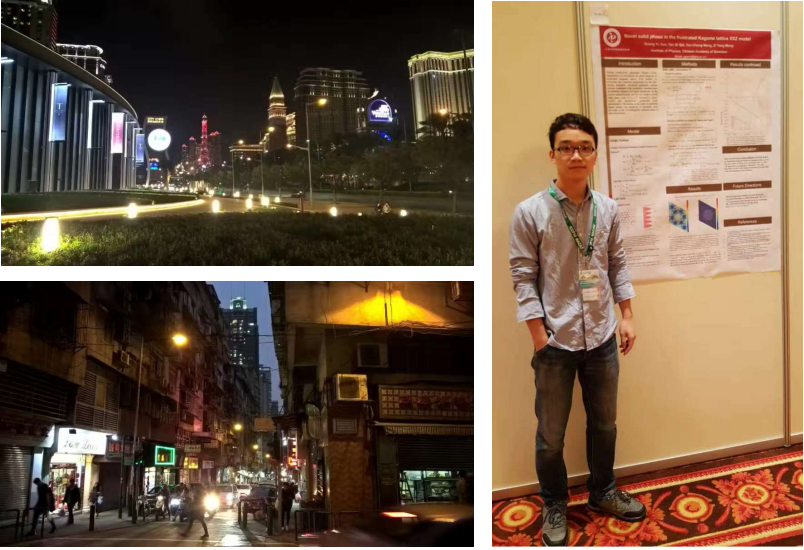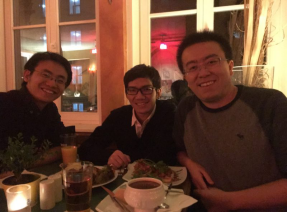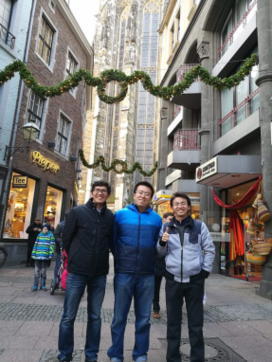Beautiful Japan at its beautiful time
After the APS march meeting this year, Zi Hong and myself paid a one week visit to Japan. We first stay at the Department of Applied Physics, University of Tokyo, where our hosts is Prof. Yukitoshi Motome, and we met Prof. Masatoshi Imada and several other friends. Scientific discussions on KPM, skyrmion lattice models, non-fermion liquid and self-learning Monte Carlo method went on very well. Tokyo, as a metropolitan city, is impressively organized and clean, and the cherry blossom of this year “officially” started during the week. Zi Hong had a good chance to practice his Japanese, which, according to me, is already at a non-trivial level. Then there is a small conference at RIKEN Advanced Institute for Computational Science at Kobe. Again, SLMC is warmly welcomed at the conference. We asked a special treat from Prof. Seiji Yunoki (our host in RIKEN) to offer us a visit to the famous K-computer, and the visit was very interesting, we were impressed by the level of carefulness of Japanese engineering spirit, and although the shear flops of K-computer is no longer the 1st on the top 500 list, its maintenance and management is indeed the world class. Our system still has a long way to go.


Encounter of real Macao from a poster
I was accepted to attend the 10th International Conference on Computational Physics( ICCP10), Jan 16-20, 2017 in Macao, China. Before landing, an idea popped into my mind that Monte Carlo algorithms come to Macao -- the gambling city in Asia -- is like a traveler returns home (of course Monte Carlo algorithms have many other homes). The first impression of Macao was that it is a prosperous and flourishing city, grand hotels and casinos in Cotai area with glorious chandeliers and golden exterior decorations. However, not until I saw those aged concrete bridge piers on the way to hotel did I feel the superficiality behind magnificence. Interestingly, it is our posters that gave us the chance to explore the real, everyday Macao: Zi Hong, Chuang and myself were accepted to participate poster session of ICCP10, we took it so seriously that not until the last moment before taking off did we settle the final version. Unfortunately, we underestimated the difficulty to find a print shop in Macao. We searched the University of Macau, Taipa and almost the entire city and finally found our lucky print shop at the corner of a back street in main island of Macao, it was a long day. Compared with the fabulous Cotai and its grand casinos, the main island of Macao is filled with old and dense residential buildings and very narrow streets (Macao is one of the most populated city). In the messy print shop, cantonese soap opera was broadcasted on a small TV and this was at this moment that I came to aware the real life in Macao.

Mercator Fellow Trip to Germany
Thanks to the generous support of German Research Foundation Research Unit FOR1807, we three (Yuan-Yao He, Xiao Yan Xu and Zi Yang Meng) took a two-week scientific visit to Germany through the Mercator Fellow program. Our hosts are Prof. Fakher Assaad at University of Wuerzburg and Prof. Stefan Wessel at RWTH Aachen University. We exchanged our works with these two groups and had in-depth discussions with their group members. Yuan-Yao and Xiao Yan gave very good seminars there, and new projects and collaborations merge from this visit. This trip is also a good culture exposure to us, such that both Yuan-Yao and Xiao Yan experienced the calm lifestyle in historical and representative German towns and the beautiful (but rainy) German autumn.



(a) Three of us having dinner at a student place near University of Wuerzburg, I used to hangout here during my phd time with local friends. (b) Not having Chinese food became a serious problem, so Xiao Yan decided to cook for himself and friends. (c) Aachen is the hisotrical residence of Charlemagne. The building in this back is the cathedral where throughout the middle ages, Holy Roman Emperors were crowned.
Summer School on Computational Approaches for Quantum Many Body Systems

Computational approaches are playing increasingly important role in the advances of condensed matter physics, in particular, in quantum many-body systems, where strong correlations among multiple degrees of freedom including electronic, spin, lattice and orbital, have rendered conventional analytic and perturbative methods inadequate. On the other hand, modern computational approaches, such as quantum Monte Carlo (QMC), density matrix renormalization group (DMRG), tensor network renormalization group (TRG) and to some extend dynamic mean-field theory (DMFT), are inherently non-perturbative and unbiased, and could, in principle, tackle quantum many-body systems in controlled manner. In light of the rapid developments in computational approaches, we organize this international summer school with scope encompassing techniques such as QMC, DMRG, TRG and DMFT. The purpose of this school is to provide a full coverage of modern computational techniques, to give in-depth understanding and first-hand experience to graduate students and junior researchers, and to subsequently boost the research activities and developments of these computational approaches in quantum many-body systems in China. The selected lecturers are active researchers working in the very front of these fields. In between the lectures, there are also seminars presented by leading international experts to give participants perspectives of the most recent developments.
Thanks to my colleague and co-organizer Lei Wang, thanks to our powerful secretaries Ms. Jianwei Qi and Jingjing Li, thanks to our domestic and international lecturers and speakers, and most of all, thanks to those 117 students coming from all over the country, who have actively participated in the Summer School. Without all of you, such successful event could not be possible.
For more details of the summer school, please visit: http://compqmb2016.csp.escience.cn
Conference on Condensed Matter Physics

The 2nd Conference on Condensed Matter Physics (CCMP) was held on July 20-22, 2016 in Nanjing, China, co-sponsored by School of Physics at Nanjing University, Collaborative Innovation Center of Advanced Microstructures at Nanjing University, and Institute of Physics, Chinese Academy of Science. As the organizor of the symposium on Quantum Many-Body and Statistical Physics, I had great time with our invited speakers from all over the world and participants. Also, many thanks to the excellent support from the Nanjing University.
For more details of the conference, please visit: http://physics.nju.edu.cn/ccmp2016/